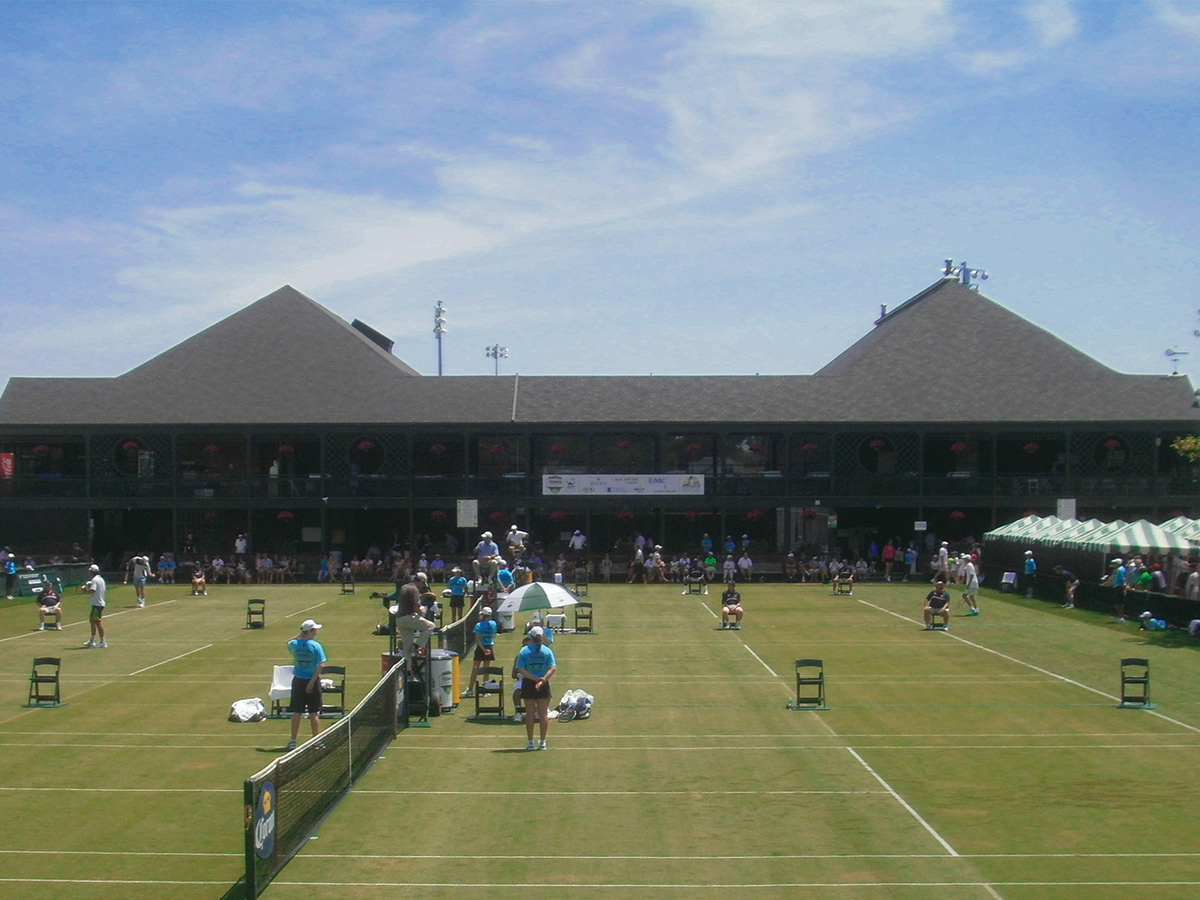This coming week the eyes of the tennis world will be on Newport as many of the players from Wimbledon will be competing in the Infosys Hall of Fame Open. This is the only ATP men’s tournament played on grass in North America and extends the tradition of tennis, which was first played on grass at the Wimbledon Cricket Club in 1877. Just four years later, in 1881 the first American championship was played in Newport, RI, which marked the beginning of tennis in the Americas. Sadly, it has been announced that due to demand from larger venues, 2024 is expected to be the last ATP sanctioned Hall of Fame Men’s Championship.
This year the tournament will be played from Sunday July 14 to Sunday July 23, 2024. The competition is an ATP 250 Men’s tournament and has both singles and doubles championships. Many of the top players from around the globe will be competing for $661,585 in prize money. Although the draw is subject to last minute change, the draw is expected to include former Hall of Fame Open Champion: American Maxime Cressy (2022), and many other top players from around the world. The tournament will also include doubles play at a world ranked level. (More information on the draw and tickets is available at www.InfosysHallOfFameOpen.com.)

ATP Matches
When the Newport Casino was first built in 1880, the game of lawn tennis was a new but quickly growing sport. The game had been derived from the more complicated and architecturally involved game now known as Real Tennis, which had been invented in 13th-century France. To make the sport of “tennis” more accessible and affordable to all, Major Walter Wingdale took the essentials of the game of hitting a ball over a net with wooden racquets and was granted a patent for his new variation of the sport by Queen Victoria in 1874.
The Newport Casino was commissioned in 1879 by James Gordon Bennett, who owned an estate across the street for the Newport Casino. He reportedly created the club after the members of the Reading Room Club objected to his polo instructor riding up the staircase to the second floor of the building on a bet. Bennett was an eccentric millionaire publisher of the New York Herald newspaper and was famous for doing exactly as he liked. He reputedly said he created the club so that people could “have a bit of fun,” thus implying such a thing had not actually possible in Newport previously. After a lightning-fast six-month design process, construction on the Newport Casino broke ground on January 8, 1880. Through the efforts of 200-300 construction laborers, the facility was opened to patrons in July of 1880, barely six months later.

ATP Audience
Bennett selected the newly remade firm of McKim Mead & White to undertake the design work. With the addition of Sanford White, the new firm successfully completed the design work for the Newport Casino and began its rapid ascent. The Newport Casino project was widely published as Newport was a place closely followed in both the social and architectural press during that time.
Located at 194 Bellevue Avenue, the Casino building is a masterpiece of the “Shingle Style,” which was popular during the 1880’s. The Shingle Style was given its name by Yale Architectural Scholar Vincent Scully in his 1955 seminal work The Stick Style and the Shingle Style. As Scully defined it, the style was a refined and simplified version of the earlier Queen Anne Revival formula, which was characterized by more polychromy and half timbering. The Shingle Style used cedar shingles cut in various patterns to create an almost painterly cloak to it asymmetric and free-formed volumes, thus giving it its name naturally and succinctly.

Tennis Hall of Fame Inductees
The Casino (meaning “little house” and not “place of gambling” in those days) represented a new sort of leisure facility with dining, sporting and other facilities under one roof—what would later become known as the “country club.” This magnificent complex is intact thanks to the vision (and generosity) of summer Newporters James and Candace Van Alen, who saved the site from becoming a strip shopping center in 1954 by inventing a new use for the facility—the Lawn Tennis Hall of Fame. In 1973, induction into the institution was widened to include international players and in 1976 it was renamed the International Tennis Hall of Fame (ITHF). This grand building complex is now home to one of the central collections of tennis history and memorabilia in the world, including the original patent, signed by Queen Victoria, for the invention of lawn tennis.
For its importance in the career of McKim, Mead and White, in the development of the American Shingle Style and in the invention of the “country club”, the Casino complex was designated a National Historic Landmark in 1987. It is a place which from its earliest day to the present has been associated with tennis in America, through the Hall of Fame located there, and with the greatest players from around the world enshrined in this Pantheon of Tennis. This venue deserves a wonderful summer tournament to carry on the great tradition of tennis in Newport and we tennis fans anxiously await news of what is going to fill this gaping hole in our summer season. Let’s hope it is something worthy of this extraordinary venue!
Ross Cann, RA, AIA, LEED AP, is an author, historian, teacher and practicing architect living and working in Newport, RI. He studied Molecular Biophysics at Yale, and holds degrees in Architectural History and Architecture Design from Cambridge University in England, and Columbia University in New York and is former president of the National Tennis Club located at the Newport Casino and has had a box for the ATP tournament for nearly twenty years.
